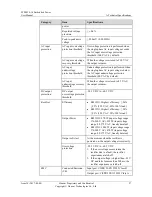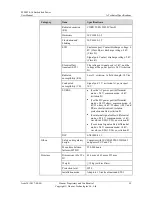
ETP4830-A1 Embedded Power
User Manual
7 Maintenance
Issue 10 (2017-08-08)
Huawei Proprietary and Confidential
Copyright © Huawei Technologies Co., Ltd.
48
2.
Check whether the load circuit breaker or fuse detection cable is disconnected. If so,
reconnect it.
7.2.12 Batt Loop Trip
Possible Causes
The battery circuit breaker or fuse detection cable is loosely connected.
The battery circuit breaker has tripped or the battery fuse has blown.
The contactor is faulty.
Measures
1.
Check whether the battery circuit breaker or fuse detection cable is loosely connected. If
so, reconnect the cable.
2.
Check whether the battery circuit breaker has tripped or the battery fuse has blown. If so,
rectify the battery loop fault and then switch on the circuit breaker or replace the fuse.
3.
Manually switch on or switch off the battery contactor and check whether the battery
current changes accordingly. If not, replace the contactor.
7.2.13 Batt Off
Possible Causes
An AC power failure occurs.
Batteries are manually disconnected.
The battery disconnection voltage is set too high on the SMU.
Rectifiers are faulty.
The system configuration is not proper.
Measures
1.
Check whether an AC power failure occurs. If yes, resume the AC power supply.
2.
Check whether batteries are manually disconnected. If yes, confirm the reason of the
manual disconnection, and reconnect the batteries after the operation.
3.
Check whether the battery disconnection voltage (43 V DC by default)is set too high on
the SMU. If yes, adjust it to a proper value.
4.
Check whether the power system capacity is insufficient for the loads due to rectifier
failures. If yes, replace the faulty rectifier.
5.
Check whether the load current is greater than the current power system capacity. If yes,
expand the power system capacity or reduce the load power.
7.2.14 Door Alarm
This alarm is generated only for the power system that has door status sensor installed.
Possible Causes
The cabinet doors are open.
The door status sensor is faulty.













































